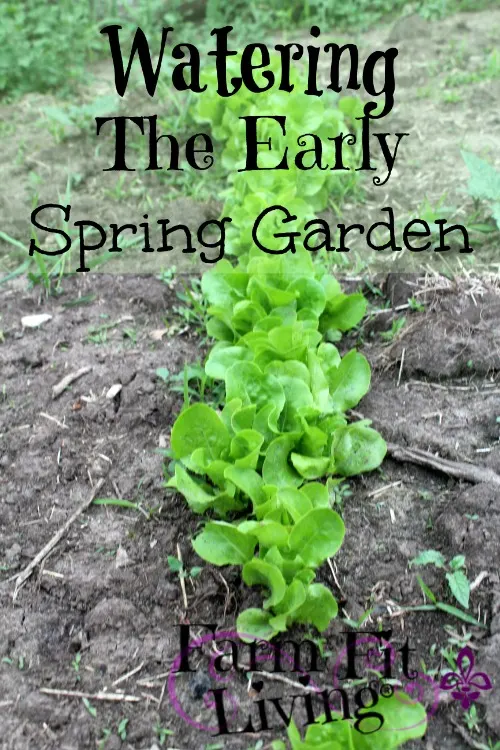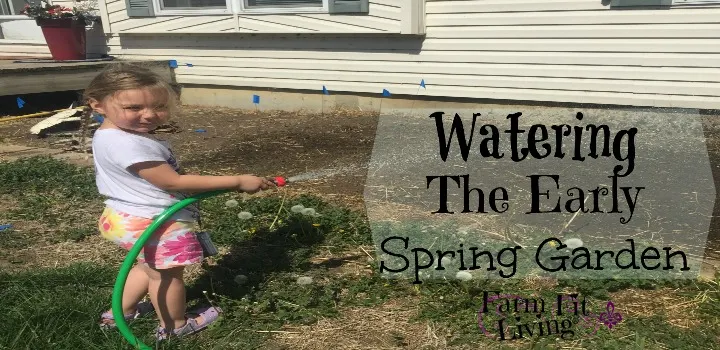There’s nothing more frustrating for a gardener than watering the early spring garden.
Watering the early spring garden crops may be annoying but necessary to establish proper growth.
Without proper moisture hitting the soil and finding the roots, plants won’t be able to flourish.
Plants that do not grow do not produce vegetables and fruits for us to enjoy. And that is just a bummer!
When the natural spring rains don’t fall, there are other ways to make sure your early spring garden plants have sufficient amounts of water.
But, how do you know when and how much water to give your plants? Read on, my friend!
How to Determine Water Amounts and Timing
There are several variables to considered when deciding to water the early spring garden.
The first variable is to determine the dryness of the soil several inches below the surface. Here’s how:
- Dig down 2 to 4 inches with a shovel or trowel to determine if soil needs additional water.
- Attempt to make a ball of soil. Dry soil will not hold together. The ball will crumble within your hands rather easily.
Another variable to realize is the type of soil you have in your garden spot. You see, soil type influences three main production variables: Root establishment, water infiltration and holding capacity.
Environmental factors are constantly working against gardeners and farmers. High temperatures, wind, and slopes can determine moisture retention in the early spring garden.
High temperatures and wind lead to water loss from evaporation. Water runs off steep slopes unless applied slowly or in increments.
Download my FREE Soil Temperature Guide HERE
Soil Type Matters
The type of soil you have greatly influences how the root system of a plant is established. This root system effects the plant’s ability to take up needed water.
Clay soils tend to hang onto water longer. Too much water on a clay soil can lead to compaction issues.
On the contrary, sandy soils tend to dry out much quicker. Therefore, plants in sandier soils require more frequent waterings.
Your soil type and the way it receives moisture depends mostly upon soil health.
A good organic diet of organic matter can help soil receive water more readily. Examples of organic matter include:
- Compost
- Peat Moss
- Cotton Burr
- Manure (Only in the “off-season”)
Tips for Watering the Early Spring Garden
So, there’s no rain in the forecast. There hasn’t been a drop of rain since you planted your early spring garden of crops such as peas, potatoes, and spinach.
After determining the dryness of the soil, you determine it’s time to take matters into your own hands.
It’s time for watering the early spring garden. Here’s how:
Be sure you’re using cool water during a cool time of the day. Hot water could scald the foliage of the plants, causing worse problems.
You can use a handheld hose with spray nozzle set to a light setting. Or, any watering can will do as well.
For a larger area, you can set up a sprinkler system to do the work for you. Be sure to check the amount of water applied. In other words, don’t forget you left your sprinkler on the early spring garden!
Thoroughly moisten the soil to a depth of 6 to 8 inches. In well amended or prepared (fluffy) soil, this should take 1 to 2 inches of water throughout.
Or, for slow waterings, simply add 1/4 inch of water at a time. Allow 30 minutes for the water to sink into the soil. Then, add another 1/4 inch if needed. This amount is the equivalent to a light spring rain.
Even if a light rain does occur, it may not be enough. You’ll want to check the soil again for saturation. Consider watering after a light rain to to take advantage of nature’s contribution.
Mulching beds with straw or leaves also helps conserve moisture and extend the irrigation interval.
Sandy soils should be watered as many as 2 to 3 times per week.
These recommendations are an average. They very depending on the site and environmental conditions.
Conserving Water
When watering the early spring garden, you might be concerned about the overuse of water. Here are some tips to conserve water when watering the early spring garden.
Drip irrigation usually applies water slowly enough so it absorbs without sitting on the top or running off. This is an ideal concept for clay soils as it moves water slowly.
Watch plants and adjust amounts and frequency as needed. The plant population also influences the amount of water needed to sustain a growing bed. The more plants growing in a given area, the greater the demand for water.
Space plants further apart but within optimum parameters. This requires less water. An ideal plant population allows foliage to overlap, shading soil between plants and reducing evaporation from the soil’s surface.
Give your new transplants a little water reserve. When planting gardens or flower beds from seed, water thoroughly after planting to establish a reserve in the top few inches of soil. Keeping the seed bed moist supports germination and softens soil, allowing seedlings to emerge.
Watering during cool times of the day results in the least amount of evaporation.
Use a mulch or compost cover to preserve moisture. Lightly cover the planted seedbed with sand, compost, or potting soil to help seedlings emerge, and distribute moisture evenly around the seed.
Give Your Early Spring Garden What It Needs
Water is one of the major nutrients plants need to survive, grow, and produce.
Depending on mother nature is sometimes not an option. We often need to take matters into our own hands.
The early spring garden plants need water to help them grow and flourish.
With a multitude of tips under your belt, you’ll now be well on your way to watering the early Spring garden.
~ Much Love ~
 DISCLOSURE: THIS POST CONTAINS AFFILIATE LINKS. THERE ARE LINKS WITHIN THIS POST ON WHICH I CAN EARN A COMMISSION IF YOU PURCHASE SOMETHING, BUT AT NO ADDITIONAL COST TO YOU. THIS IS HOW I CAN CONTINUE TO POST HIGH QUALITY CONTENT FOR YOUR ENJOYMENT.
DISCLOSURE: THIS POST CONTAINS AFFILIATE LINKS. THERE ARE LINKS WITHIN THIS POST ON WHICH I CAN EARN A COMMISSION IF YOU PURCHASE SOMETHING, BUT AT NO ADDITIONAL COST TO YOU. THIS IS HOW I CAN CONTINUE TO POST HIGH QUALITY CONTENT FOR YOUR ENJOYMENT.




Summer Squash Sausage Skillet || Farm Fit Living
Wednesday 18th of July 2018
[…] of yellow squash into black plastic mulch for weed control. The main care for these plants include watering while they are growing and also while the buds are developing. You’ll see gorgeous yellow […]
Spring Berry Pie Recipe for Anytime of the Year | Farm Fit Living
Friday 30th of March 2018
[…] Plenty of moisture in the soil. When the weather is dry, you should plan on watering the strawberries. Read More about Watering Tips Here […]
7 Low Cost Garden Hacks to Help Save Money Gardening
Saturday 3rd of March 2018
[…] For More Garden Watering Hacks, go here. […]
Summer Garden Planting Guide for Home Gardens
Saturday 6th of May 2017
[…] ** Read HERE how to water a garden properly if there’s no rain. […]
7 Tips for Gardening With Children | Farm Fit Living
Monday 1st of May 2017
[…] Watering the garden […]